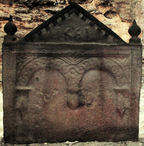-
123
Description: Rectangular; top panel with bearded face between symmetrical horizontal scrolls, and faces at either end; scrolls are repeated below, on either side of the date, all above a horizontal double fillet; below, a pair of arches with guilloche decoration between fillets, and toothed on the underside, are supported on each side by Tuscan columns, also with guilloche decoration; this is repeated in symmetrical rectangular panels on either side; at the centre base a bulbous nozzle protrudes.
Notes: This is a smith's forge fireback, the nozzle being the tuyere directing the air into the fire from bellows behind. Stylistically similar to the Lenard and other firebacks of the same period, the carved elements above the nozzle may have been cast from a pattern inspired by the back of a joined 'wainscot' chair, with the date inserted. The back may have been used for forging non-ferrous metals as there was a trade in pot-founding in bronze as well as iron at some ironworks in the Weald. Formerly part of the Ade Collection (from Grove Hill, Hellingly, Sussex).
Inscription: 1655
- Decoration tags:
- rectangular with round arch (shape)
- fillet (edging)
- whole carved pattern
- individual numbers
- architectural
- text
- humans
Manufactured: in 1655 in the Weald area of England.
Current location: Hastings Museum and Art Gallery, John's Place, Bohemia Road, Hastings, East Sussex, England.
Museum number: HASMG: 1952.51.62 (part of the Hastings Museum museum group)
Citation: Butterfield, W. R., 1916, 'Old Wealden Firebacks', The Connoisseur, 46, pp. 197-209.
- Attached to series:
- Chair pattern firebacks
- Furniture stamp firebacks
-
925
Description: Rectangular panel with moulded edging (top and sides); two joined guilloche arches with bracket ends and floral designs in the spandrels; above, pediment with dentil edging, between teardrop pinnacles; date in bottom centre of pediment; possible initials below and between arches.
Notes: The pattern has been formed from, or in imitation of, the upper part of the back of a joined 'wainscot' chair with an inserted date and possible inserted initials
Inscription: 1661 / [?W] [?H]
- Decoration tags:
- rectangular with triangular arch (shape)
- complex, furniture-derived (edging)
- whole carved pattern
- individual numbers
- architectural
- text
Manufactured: in 1661 in England.
Current location: in private hands, Wigmore, Herefordshire, England.
- Attached to series:
- Chair pattern firebacks
- Furniture stamp firebacks

